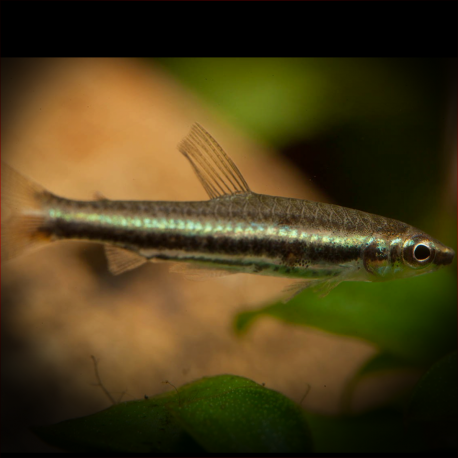More info
Datasheet
| Minimum Tank Size | 40 litres / 10.57 US gallons |
| Maximum Size | 2.3cm / 0.91inches |
| Temperature | 22°C / 71.60°F - 28°C / 82.40°F |
| Hardness | 1.01dgH / 18ppm - 5.04dgH / 90ppm |
| pH | 4.0-6.5 |
General Description
The Least Pencilfish (Nannostomus Minimus) is the second-smallest member of its genus, distinguished by a prominent dark lateral stripe, modified anal fin in males, and a patch of red chromatophores on the flanks. It exhibits a cryptic, vertically-barred color pattern at night and belongs to the Lebiasinidae family within the Characiformes order.
Aquarium Setup
For optimal care, the Least Pencilfish should be housed in a heavily-planted aquarium with a dark substrate, driftwood branches, and dried leaf litter. The presence of floating plants helps reduce skittishness while providing a natural environment for the fish.
Behaviour
This species is very peaceful but is not ideal for community tanks due to its small size and timid nature. It tends to shoal rather than school and displays natural behaviors when kept in larger groups. Male rivalry is common during daylight hours.
Feeding and Diet
As a micropredator, the Least Pencilfish feeds on tiny invertebrates and zooplankton in the wild. In captivity, they accept dried foods but require small live and frozen fare such as Artemia nauplii and grindal worms for optimal health.
Reproduction & Dimorphism
Reproduction in aquaria can be successful with controlled conditions and the presence of fine-leaved plants or wool mops. Adult males are more intensely-patterned, colorful in the fins, and slimmer compared to females.
Habitat and Distribution
In the wild, N. minimus inhabits sluggish blackwater tributaries and swampy areas with dense vegetation and submerged structures. It's found in Guyana's Potaro and Mazaruni River systems, preferring areas with abundant cover in sympatry with N. espei.
Distribution
The Least Pencilfish has been recorded in various localities within Guyana's Potaro and Mazaruni River systems, typically in areas with minimal dissolved minerals and acidic pH levels as low as 4.0.

